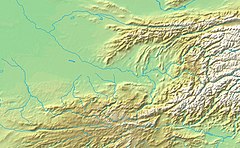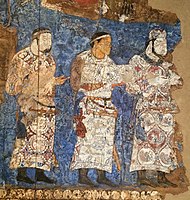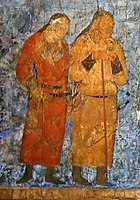Afrasiab murals
| Afrasiab murals | |
|---|---|
 Detail of the Ambassadors' Painting. | |
| Created | 648-651 CE |
| Discovered | Afrasiyad, Samarkand, Uzbekistan 39°40′09″N 66°59′36″E / 39.669300°N 66.993400°ECoordinates: 39°40′09″N 66°59′36″E / 39.669300°N 66.993400°E |
| Present location | Afrasiab Museum of Samarkand, Uzbekistan |
| Culture | Sogdian |
 | |
The Afrasiab murals, also called the Paintings of the Ambassadors, is a rare example of Sogdian art. It was discovered in 1965 when the local authorities decided the construction of a road in the middle of Afrāsiāb mound, the old site of pre-Mongol Samarkand. It is now preserved in a special museum on the Afrāsiāb mound.
Description[]
The paintings dates back to the middle of the 7th century CE. They were probably painted between 648 and 651 CE, as the Western Turkic Khaganate, members of which appear abundantly in the mural, was in its last days before its fall in 657 CE, and the Tang Dynasty was increasing its territory in Central Asia.[1][2][3] On the four walls of the room of a private house, three or four countries in neighbouring Central Asia are depicted. On the northern wall China (a Chinese festival, with the Empress on a boat, and the Emperor hunting), on the Southern Wall Samarkand (i.e.; the Iranian world: a religious funerary procession in honor of the ancestors during the Nowruz festival), on the eastern wall India (as the land of the astrologers and of the pygmies, but the painting is much destroyed there).
The topic on the main wall, the western wall facing the entrance is debated between specialists. Kökturk soldiers are escorting ambassadors coming from various countries of the world (Korea, China, Iranian principalities etc.). There are three main hypotheses. The leading expert on Sogdian painting, the excavator of Panjikent, B. Marshak points out that Sogdian painting, gods are always depicted on the top of the main wall. However, as the Turks are guiding the embassies but are not themselves ambassadors, it has been suggested also that the Turkish Qaghan, then lord of inner and central Asia, might be depicted there. A Chinese text is indeed saying that the idea of the "Four Lords of the World", here China, India, Iran and Turks, is depicted on the walls of palaces near Samarkand precisely during this period, and this would perfectly fit the four walls of this room. The last hypothesis makes use of an inscription mentioning the king of Samarkand to propose the idea that the ambassadors are presenting their gifts to him.
The four walls of the palatial room in Afrasiab seem to depict the four principal civilizations in play in central Asia at that time: a Chinese depicting Chinese scene, a panel for India, an Iranian panel with the depiction of a religious ceremony during Nowruz, and possibly a Turk panel, showing numerous ambassadors being guided by Turkic officer towards a ruler, who could be a Turk Khagan.[4]
Inscription mentioning Varhuman and the ambassadors[]
In the murals of Afrasiab, an inscription mentioning Varhuman has been found. It is written in Sogdian:
 Afrasiab Sogdian inscription
Afrasiab Sogdian inscriptionWhen King Varkhuman Unash came to him [the ambassador] opened his mouth [and said thus]: "I am Pukarzate, the dapirpat (chancellor) of Chaganian. I arrived here from Turantash, the lord of Chaganian, to Samarkand, to the king, and with respect [to] the king [now] I am [here]. And with regard to me do not have any misgivings: About the gods of Samarkand, as well as about the writing of Samarkand I am keenly aware, and I also have not done any harm to the king. Let you be quite fortunate!" And King Varkhuman Unash took leave [of him]. And [then] the dapirpat (chancellor) of Chach opened his mouth.
— Inscription on an ambassador's robe.[5]
Western Turk officers and courtiers[]
In contrast with the ambassadors from various countries, the Western Turks in the mural do not bear gifts. They are considered are attendants to the scene, and military escorts to the foreign ambassadors. They are all recognizable by their long plaits.[6]
The ambassadors from various countries may have been paying homage both to king Varkhuman and possibly Western Turk Khagan Shekui, who were both nominal vassals of China. The numerous Turkish officers and courtiers who are present may suggest the predominance of the Western Turks at the court of Samarkand during this time period.[1]
In the mural, the Western Turks are ethnic Turks, Nushibis, rather than Turkinized Sogdians, as suggested by the marked Mongoloid features and faces without beards.[7] They are the most numerous ethnic group in the mural, and are not ambassadors, but rather military attendants.[7] Their depiction offers a unique glimpse into the costumes of the Turks in the 6-7th century CE.[7] They typically wear 3 or 5 long long plaits, often gathered together into a single long one.[7] They have ankle-long monochromic sleeved coats with two lapels.[7] This fashion for the collar is first seen in Khotan near Turfan, a traditional Turkic land, in the 2nd-4th century CE.[7] They have low black sharp-nosed boots. They wear gold bracelets with lapis lazuli or pearls.[7]
Overview[]
There are four walls, with murals in various states of preservation. There were two registers, an upper and lower one, but the upper register of the murals was essentially destroyed by bulldozers during the construction works that led to the discovery of the murals.[6]
Various reconstructions for the whole mural have been proposed.[8]
Original murals (details)[]

Afrasiab Palace Fresco 7th-8th century. Sogdian Chamberlains & Interpreter Introduce Tibetan Messengers
Chinese boat

Afrasiab Palace Fresco 7th-8th century. Sogdian King of Samarkand Varkhuman
Restoration[]
In early 2014, France declared that it would finance the restoration of the Afrasiab painting.[11]
See also[]
Sources[]
- Marshak, Boris; Grenet, Frantz; Sadowska-Daguin, Malgoržata (1994). "Le programme iconographique des peintures de la "Salle des ambassadeurs" à Afrasiab (Samarkand)". Arts Asiatiques. 49 (1): 5–20. doi:10.3406/arasi.1994.1349.
References[]
- ^ Jump up to: a b c d e f g h i Baumer, Christoph (18 April 2018). History of Central Asia, The: 4-volume set. Bloomsbury Publishing. p. 243. ISBN 978-1-83860-868-2.
- ^ Whitfield, Susan (2004). The Silk Road: Trade, Travel, War and Faith. British Library. Serindia Publications, Inc. p. 112. ISBN 978-1-932476-13-2.
- ^ Mode, Markus (2006). "Reading the Afrasiab Murals: Some Comments on Reconstructions and Details" (PDF). Rivista degli studi orientali. 78: 112. ISSN 0392-4866. JSTOR 41913392.
- ^ Vaissière, Etienne de la (212). "Oxford Handbook of Late Antiquity: 5 Central Asia and the Silk Road". In S. Johnson (Ed.), Oxford Handbook of Late Antiquity, Oxford University Press, P. 142-169. Oxford University Press: 144–160.
- ^ "Afrosiab Wall Painting". contents.nahf.or.kr. NORTHEAST ASIAN HISTORY FOUNDATION.
- ^ Jump up to: a b c Library, British (2004). The Silk Road: Trade, Travel, War and Faith. Serindia Publications, Inc. p. 110. ISBN 978-1-932476-13-2.
- ^ Jump up to: a b c d e f g Yatsenko, Sergey A. (2004). "The Costume of Foreign Embassies and Inhabitants of Samarkand on Wall Painting of the 7th c. in the "Hall of Ambassadors" from Afrasiab as a Historical Source". Transoxiana. 8.
- ^ Yatsenko, Sergey A. (2009). "Early Turks: Male Costume in the Chinese Art Second half of the 6th – first half of the 8th cc. (Images of 'Others')". Transoxiana. 14: Fig. 3.
- ^ For an alternative interpretation, see: de la Vaissière, Étienne (2006). "LES TURCS, ROIS DU MONDE À SAMARCANDE". Rivista degli studi orientali. 78: 147–162. ISSN 0392-4866. JSTOR 41913394.
- ^ Jump up to: a b c d Whitfield, Susan (2004). The Silk Road: Trade, Travel, War and Faith. British Library. Serindia Publications, Inc. p. 110. ISBN 978-1-932476-13-2.
- ^ http://old.archeo-news.ru/2014/02/blog-post_8042.html
- ^ Compareti (University of California, Berkeley), Matteo (2007). "The Chinese Scene at Afrāsyāb". Eurasiatica.
- ^ Grenet, Frantz (2004). "Maracanda/Samarkand, une métropole pré-mongole". Annales. Histoire, Sciences Sociales. 5/6: Fig. D.
- ^ Jump up to: a b Compareti (University of California, Berkeley), Matteo (2015). "Ancient Iranian Decorative Textiles". The Silk Road. 13: 38.
- ^ Grenet, Frantz (2004). "Maracanda/Samarkand, une métropole pré-mongole". Annales. Histoire, Sciences Sociales. 5/6: Fig. B.
- ^ Gordon, S. (30 April 2016). Robes and Honor: The Medieval World of Investiture. Springer. p. 47. ISBN 978-1-349-61845-3.
| Wikimedia Commons has media related to Afrasiyab museum paintings. |
Royal Nawrūz in Samarkand: Acts of the Conference held in Venice on the Pre-Islamic Afrāsyāb Painting, ed. M. Compareti and E. de La Vaissière, Rome, 2006.
External links[]
- Court art of Sogdian Samarqand in the 7th century AD - images and commentary at the University of Halle
- 7th-century paintings
- 1965 archaeological discoveries
- Samarkand
- Murals
- Sogdians
- Sogdian art






















